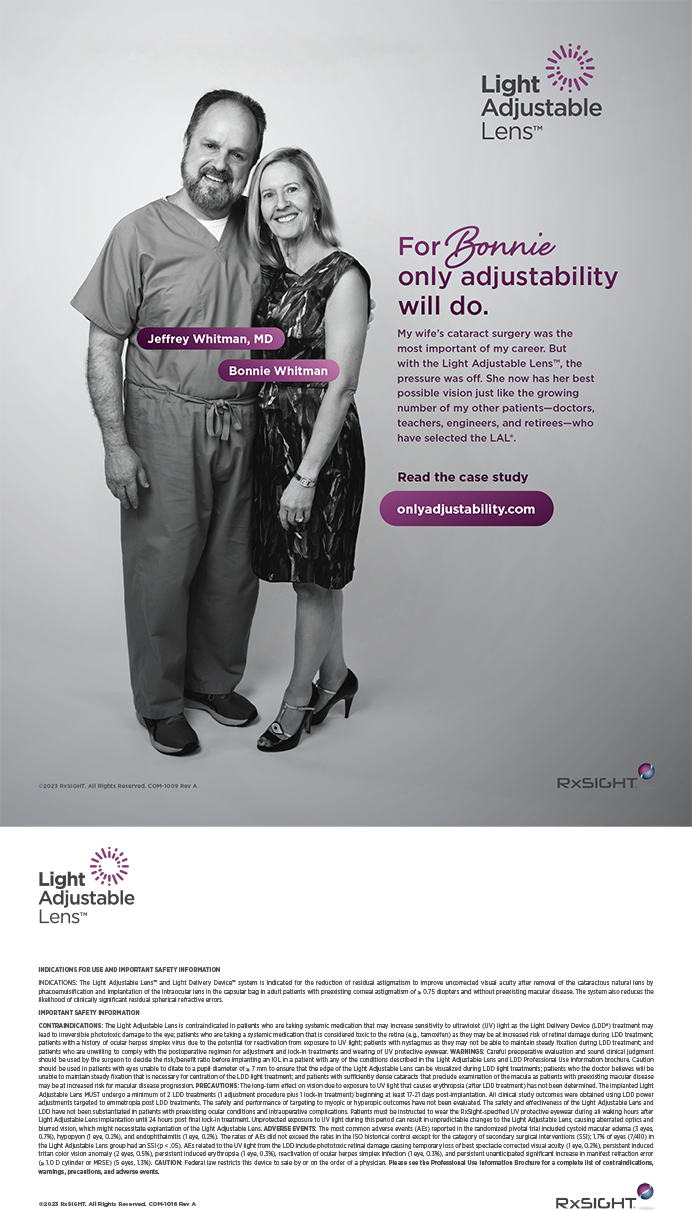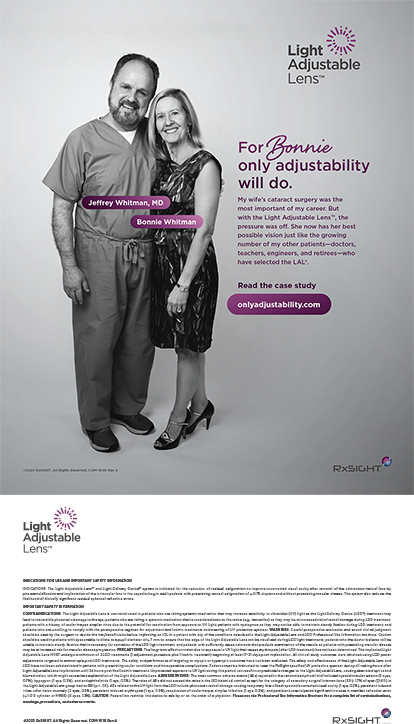The future of refractive surgery remains bright despite the recent economic downturn. Although laser procedures such as LASIK are what may first come to mind when one thinks of refractive surgery, the implantation of IOLs to correct refractive errors is certain to become more popular among patients. Issues of safety require further study and address, but it is only a matter of time until phakic IOLs enter the mainstream of refractive surgery.
The intriguing aspect of phakic IOLs is that the surgery is a procedure of addition: a lens is added to the optical system (and could later be removed). In contrast, laser treatment is a procedure of subtraction: tissue is irreversibly removed. This alteration of the cornea's shape can dramatically affect patients' quality of vision, whereas inserting a phakic IOL leaves the optical system intact and minimally affects the quality of vision, if at all.
Phakic IOLs can be categorized in terms of their location in the eye (ie, the anterior or posterior chamber, iris plane/fixated). Pupillary ovalization and the loss of corneal endothelial cells have been particular safety concerns with anterior chamber, angle-supported phakic IOLs. Alcon Laboratories, Inc. (Fort Worth, TX), designed the AcrySof Phakic lens to avoid these problems. The results thus far from ongoing US clinical trials and previously completed European and Canadian studies are encouraging. Despite the withdrawal of other angle-supported phakic IOLs in France, the AcrySof Phakic IOL recently received the CE Mark in Europe and is currently in clinical use, including in France.
DESIGN
The AcrySof Phakic IOL is constructed of a foldable hydrophobic acrylic material that has demonstrated biocompatibility, and its haptics are uniquely configured to achieve predictable refractive outcomes, stable vaulting, and low compression forces on the angle in order to minimize the loss of corneal endothelial cells and pupillary ovalization. Soft and flexible, the haptics conform well to the shape of the angle while keeping the IOL vaulted so that it lies at a safe distance from the corneal endothelium and crystalline lens.
The implant has a 6.0-mm optic and was investigated in a dioptric power range from -6.00 to -16.50. The ACIOL is available in four overall lengths: 12.5, 13.0, 13.5, and 14.0 mm. The idea is to allow surgeons to customize the lens' fit based on each patient's anterior chamber anatomy. Determinations of the IOL's size were based on white-to-white measurements with a caliper, although measurements were also obtained with anterior segment optical coherence tomography pre- and postoperatively for comparison.
DATA
Methodology
Pooled data were recently reported from a European phase 3 study (190 patients), a Canadian phase 3 study (120 patients), and a US phase 2 study (50 patients). Together, these multicenter trials enrolled 360 subjects, and data were available from the 3-year visit for 104 subjects.1
Patients enrolled in the studies had to be over 18 years of age, and in the US and Canada, a maximum age limit of 49 years was set. Patients had to demonstrate stable moderate-to-high myopia, with no more than 2.00 D of astigmatism, a mesopic pupillary size no greater than 7 mm, and an anterior chamber depth of at least 3.2 mm. Patients with a personal or family history of glaucoma were excluded, and there were age-dependent criteria on endothelial cell density for patient selection.
Outcomes
At the 3-year visit, 46% of eyes achieved a distance UCVA of 20/20 or better, 73% saw 20/25 or better without correction, and 97% achieved 20/40 or better acuity. BSCVA was 20/20 or better in 81% of eyes, 20/25 or better in 98%, and 20/40 or better in 100%. No eyes lost more than two lines from their preoperative BSCVA, and only 1% lost two lines. Almost 60% of eyes achieved an increase in BSCVA of one line or more.
The refractive results showed excellent stability and predictability. The manifest refraction spherical equivalent was -10.41 D preoperatively, -0.25 D at 1 month, and -0.24 D at 3 years. The achieved manifest refraction spherical equivalent was within 1.00 D of target in 91% of eyes and within 0.50 D in 79% of eyes. Data were analyzed in spherical equivalent.
Ninety-five percent of patients (including those from whom the IOL was explanted) said that they would undergo the implantation of the same lens again.
A secondary intervention or other surgical treatment was performed on a total of 13 eyes. These included two eyes in which the IOL was replaced for wrong power and four eyes from which the IOL was explanted at the patient's request (three for undesirable visual symptoms and one for cataract). Other surgical interventions included the placement of a suture (one eye), prophylactic laser peripheral iridotomy (one eye), retinal laser treatment (two eyes), iris cyst laser (one eye), and PRK (two eyes). A preoperative peripheral iridotomy was not required.
Safety
Endothelial safety is being evaluated through the assessment of images at a central reading center, including an analysis for changes in cell morphology and in central and peripheral (superior nasal) endothelial cell density from 6 months onward. Six months to 3 years after the AcrySof Phakic IOL's implantation, central endothelial cell density decreased by only -0.41% on average, and the peripheral cell count changed by -1.11%. Data for the coefficient of variation and percentage of hexagonality also showed minimal change.
There were no significant surgery-related complications, including no cases of endophthalmitis, hyphema, hypopyon, lens dislocation, cystoid macular edema, pupillary block, or retinal detachment. From baseline to any visit through 3 years after surgery, 36.5% of patients experienced rotation of the IOL of greater than 15°, but it was not associated with any clinical sequelae. Occurring in 10 eyes (2.8%), elevated IOP more than 1 month after surgery that required treatment was the most frequently observed adverse event. Eight of the 10 cases were due to a steroid response, and in no case was the increase in IOP persistent.
Six eyes (1.7%) developed peripheral anterior synechiae, but there were no cases of pupillary ovalization (Figure 1). Cataract developed in seven eyes (1.9%). In three of these, the opacity was thought to be related to lens touch during implantation surgery. In the other four eyes, the etiology was unknown, considered age-related, or associated with concurrent ophthalmic disease.
CONCLUSION
The results from 3 years of follow-up in North American and European multicenter clinical trials of the AcrySof Phakic IOL indicate that this foldable angle-supported implant has a favorable safety profile and excellent effectiveness for the treatment of moderate-to-high myopia (Figure 2). Data from a 3-year follow-up visit in 104 eyes show excellent stability, predictability, and visual outcomes with a low rate of adverse events. The author looks forward to the completion of the 3-year US clinical FDA study and, he hopes, this IOL's ultimate approval.
Stephen S. Lane, MD, is a managing partner of Associated Eye Care in St. Paul, Minnesota, and is an adjunct clinical professor for the University of Minnesota in Minneapolis. He is a consultant to and receives lecture fees from Alcon Laboratories, Inc. Dr. Lane may be reached at (651) 275-3000; sslane@associatedeyecare.com.


